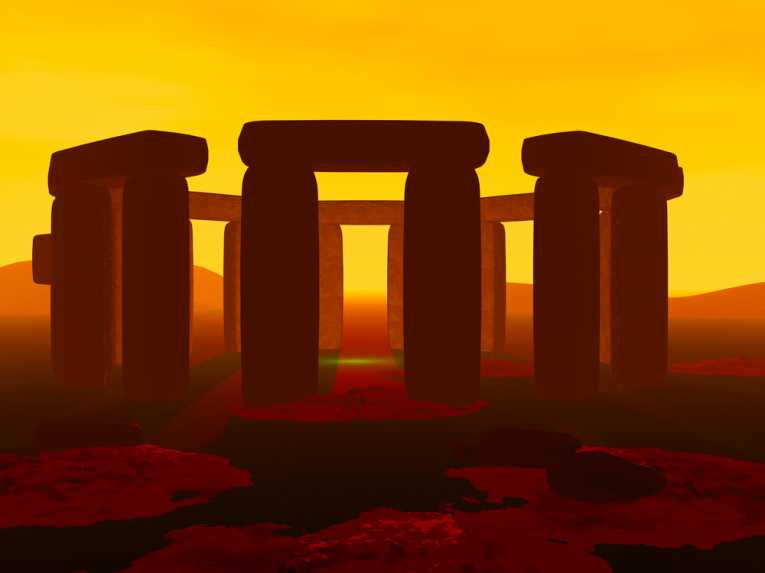Archaeologists carrying out the world's biggest virtual excavation believe ancient sun worship may have taken place near the Stonehenge monument. They have found evidence that two massive pits existed along the path of the sun at Stonehenge Cursus, a large Neolithic site in Wiltshire, UK and may have defined the route of a ceremonial procession.
This may be the first time that a firm link has been found between the ceremonies at Stonehenge and activity in the Cursus.
The pits may have housed stones, posts or fires used to celebrate the sun and mark the route of a procession of agricultural workers at summer solstice, researchers believe.
The discoveries were made by an archaeological survey team headed by the University of Birmingham's IBM Visual and Spatial Technology Centre, the Ludwig Boltzmann Institute for Archaeological Prospection and Virtual Archaeology, in Vienna.
Project leader, Professor Vince Gaffney, an archaeologist from the University of Birmingham, says: "This is the first time we have seen anything quite like this at Stonehenge and it provides a more sophisticated insight into how rituals may have taken place within the Cursus and the wider landscape.
"These exciting finds indicate that even though Stonehenge was ultimately the most important monument in the landscape, it may at times not have been the only, or most important, ritual focus and the area of Stonehenge may have become significant as a sacred site at a much earlier date.
"Other activities were carried out at other ceremonial sites only a short distance away. The results from this new survey help us to appreciate just how complex these activities were and how intimate these societies were with the natural world.
"The perimeter of the Cursus may well have defined a route guiding ceremonial processions which took place on the longest day of the year."
The pits are inside the Cursus path, along the route of the midsummer sunrise and sunset when viewed from the Heel Stone, near the Stonehenge entrance.
The archaeological team have also found a previously undiscovered gap in the centre and north side of the Cursus, which could have been the main entry and exit for processions.
In total, the Cursus is around 2.5km long and 100metres wide. It lies north of Stonehenge, runs west to east and is older than the main site.
Professor Gaffney adds, "It now seems likely that other ceremonial monuments in the surrounding landscape were directly articulated with rituals at Stonehenge.
"It is possible that processions within the Cursus moved from the eastern pit at sunrise, continuing eastwards along the Cursus and, following the path of the sun overhead, and perhaps back to the west, reaching the western pit at sunset to mark the longest day of the year. Observers of the ceremony would have been positioned at the Heel Stone, of which the two pits are aligned."
Dr Henry Chapman, Senior Lecturer in Archaeology and Visualisation, says, "If you measure the walking distance between the two pits, the procession would reach exactly half-way at midday, when the sun would be directly on top of Stonehenge. This is more than just a coincidence, indicating that the exact length of the Cursus and the positioning of the pits are of significance."
Archaeologists believe that Stonehenge was the most important monument in the Neolithic and Bronze Ages and was built by farming communities, who depended on the sun, to mark astronomical events. It is surrounded by other sacred sites that are much older than Stonehenge.
The team has also discovered some large pits arranged in a horseshoe shape to the north east of Stonehenge. They also could have contained posts and, along with a henge-type monument, may have been small shrines.
Paul Garwood, Lecturer in Prehistory at the University of Birmingham, says, "Our knowledge of the ancient landscapes that once existed around Stonehenge is growing dramatically as we examine the new geophysical survey results. We can see in rich detail not only new monuments, but entire landscapes of past human activity, over thousands of years, preserved in sub-surface features such as pits and ditches. This project is establishing a completely new framework for studying the Stonehenge landscape."
The research is part of the world's biggest virtual excavation, called the Stonehenge Hidden Landscape Project, which started in Summer 2010. Archaeologists use state-of-the-art geophysical imaging techniques to recreate the prehistoric landscape around Stonehenge.
Professor Wolfgang Neubauer, Director of the Ludwig Boltzmann Institute, says: "The LBI provides the best academics, technicians and young researchers in a team of 20 people and uses multiple systems designed for use on projects where the scale of work was previously unachievable. The use of non-invasive technologies provides information for virtual archaeologies that can be disseminated to the public via the web, iPad or mobile phone."
Dr Christopher Gaffney, lecturer in Archaeological Geophysics at the University of Bradford, says: "Building on our work from last year we have added even more techniques and instruments to study this remarkable landscape. It is clear that one technique is not adequate to study the complexity of the monuments and landscape surrounding our most important archaeological monument and the battery of techniques used here has significantly increased the certainty of our interpretation."










